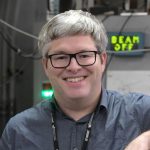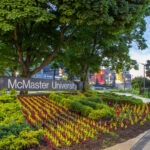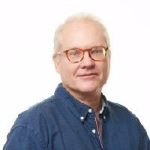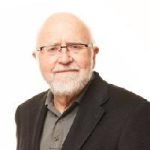People Listing
Pat Clancy
Assistant Professor
Research Interests: The study of novel materials using x–ray and neutron scattering techniques
Bruce Gaulin
Distinguished University Professor
Research Interests: Geometrically frustrated magnets, Quantum Magnets with singlet ground states, High temperature superconductors
I am an experimental condensed matter physicist, working in the general area of scattering studies of exotic ground states in new, mostly magnetic, materials. As described below, this means that we (my grad students, postdocs, collaborators and myself) make new materials which we think will have interesting and exotic ground states, and then take these materials to forefront neutron and x-ray scattering facilities in North America and around the world. We perform scattering experiments on these new materials and then work either independently or with our friends in theory to interpret the experiments, and thereby shed light on the exotic properties of the new materials.
How do we generate materials which exhibit exotic ground states? Well, we try to incorporate features into the crystal structure and the nature of the magnetic moments which encourage fluctuations, and thereby make it difficult for the material to find an ordered state at low temperatures. We have three features we can work with: we can make crystal architectures which are likely to show geometrical frustration; we can make magnetic crystals which have quantum magnetic moments in them, especially s=1/2 magnetic moments; and we can make three dimensional crystals which are made up of an assembly of low dimensional substructures, like stacks of quasi-two dimensional planes of atoms.
At present we have three themes to our work:
Geometrically frustrated magnets: these are magnetic materials which possess local geometries and magnetic interactions whose combination is incompatible with long range order. The easiest to appreciate occurrence of geometrical frustration happens with the combination of antiferromagnetism and triangular geometries. The tetrahedron is to three dimensions what the triangle is to two dimensions, so this is a common, but poorly understood occurance in three dimensional crystal structures made up of networks of interconnected tetrahedra.
We have been particularly active studying cubic “pyrochlore” magnets, which can be thought of in terms of magnetic moments decorating a network of corner sharing tetrahedra. Such materials have much difficult reaching a magnetically ordered state at low temperatures, and can display a host of exotic, disordered magnetic ground states such as spin liquid, spin glass, and spin ice states. We have devoted much effort to studying the rare earth titanate family of cubic pyrochores. You can look up our recent work on Yb2Ti2O7, Ho2Ti2O7, Er2Ti2O7, and Tb2Ti2O7 under publications. Grad students Jacob, Pat, Kate, and Katharina, and postdoc Jeremy have been leading these and related projects.
Quantum Magnets with singlet ground states: these are magnetic materials comprised of s=1/2 quantum magnetic moments decorating various lattices. One interesting and basic result of quantum mechanics is that while the classical picture of ferromagnetism corresponding to all spins in a solid pointing in the same direction is also valid when quantum mechanics is taken into account, the classical Neel state for antiferromagnetism is not correct when a fully quantum treatment of antiferromagnetism is necessary.
In these cases, which is really all cases as quantum mechanics applies to everything, antiferromagnetic interactions between the quantum moments can result in the formation of local singlets and an overall non-magnetic ground state. While the ground state is a non-magnetic singlet, the excited states, which we can probe by neutron spectroscopy, are triplet states and multi-triplet states. Application of a magnetic field Zeeman-splits the triplet state and a strong enough magnetic field can drive the energy of one of the triplet of excited states below the ground state. The net effect is that triplets can begin to condense into a “sea” of singlets and crystallize within the non-magnetic ground state in phenomena very closely related to Bose condensation.
We‚Äôve focused on two types of quantum antiferromagnets which display singlet non-magetic ground states: the quasi-two dimensional Shastry-Sutherland system SrCu2(BO3)2 and quasi-one dimensional spin-Peierls systems. In the first case, the s=1/2 magnetic moments are already arranged into pairs which then form singlets at low enough temperatures. In the spin-Peierls case, uniform chains of s=1/2 magnetic moments must spontaneously “dimerized” to form a necklace of pairs of ions which then form singlets. In the latter case, the quantum magnetism and the lattice on which the s=1/2 moments reside are strongly coupled. You can look up some of our recent publications for both these materials. The SrCu2(BO3)2 was led by Sara Haravifard, who just finished her PhD and is now a postdoc at the University of Chicago. The spin-Peierls work on TiOBr and TiOCl is being led by Pat Clancy.
High temperature superconductors: Actually high temperature superconductors are also quantum magnets – doped quantum magnets, decorating a low dimensional structure, a two dimensional one in this case. So these materials combine a couple of the general themes we are interested in.
Many scientists have been interested in these materials for more than 20 years, mostly because they display superconductivity at temperatures as high as ~ 150 K. We have focused on the magnetism in the so-called “parent” materials in the High Tc family, and on how this magnetism is modified at relatively low doping. The “doping” means that we start out with a pure “parent” compound, La2CuO4, and then replace a small percentage (like 1 -10 %) of the La3+ with Ba2+. Its known that the effect of this doping is to remove s=1/2 quantum magnetic moments from the CuO2 plane in these materials. The magnetic phase diagram of these materials in this low doping regime is remarkable (at least to me!), in that the magnetism evolves from a strong, three dimensional, commensurate antiferromagnet through a couple of different, but related two dimensional, incommensurate antiferromagnetic states, one of which also displays the superconductivity. Our work on La(2-x)Ba(x)CuO4 is being led by grad students Greg, Jerod and Kate.
Supervisor Letter:
Bruce D. Gaulin
Professor and Brockhouse Chair in the Physics of Materials
Director, Brockhouse Institute for Materials Research
Dear Prospective Graduate Student;
Thank you for your interest in experimental condensed matter physics at McMaster. I am primarily interested in studying exotic phases of matter by neutron and x-ray scattering techniques. These phases are typically generated by unusual magnets which remain in entropy-dominated, disordered states down to very low temperatures; by quantum magnets where a non-magnetic singlet ground state occurs at low temperatures, and by high temperature superconductors which may display novel “stripe” phases in which magnetism and superconductivity co-exist in an inhomogeneous fashion.
My graduate students and postdoctoral fellows study these exotic materials by carrying out neutron and x-ray scattering experiments to determine the atomic and magnetic structure and dynamics of the materials, typically as a function of temperature. I presently have six grad students, Jacob Ruff, Pat Clancy, Kate Ross, Katharina Fritsch, Greg van Gastel, and Jerod Wagman, and one postdoctoral fellow, Dr. Jeremy Carlo. Jacob and Kate came to my group from the University of Waterloo, Pat from St. Francis Xavier University, Katharina from University of Leipzig in Germany, Greg and Jerod from the University of Toronto and Jeremy recently completed his PhD at Columbia University in the USA.
I have supervised or co-supervised about 25 very talented grad students and postdocs as a faculty member at McMaster. They have all gone on to exciting careers as faculty members themselves (at the U. of Toronto, Edinburgh U., Kent State U., the Technical University of Munich), as scientists at prestige government laboratories (at the Staecie Institute of NRC, NIST, Oak Ridge National Laboratory, Los Alamos National Laboratory, Lawrence Livermore National Laboratory, Argonne National Laboratory, Helholtz Zentrum Berlin, Defence Research Establishment, Ottawa), and in high tech industry (at Seagate, JDS Uniphase, Read Rite Corp, and Moli Energy).
Neutron and x-ray scattering are very similar techniques, although they provide different and complementary information regarding the structure of materials. A student who has been trained in one of the techniques will have an easy time with the other, as they have so much in common with each other. I have built up and operate an x-ray scattering lab at McMaster, based on an 18 kW rotating anode x-ray generator, and we have the capability to carry out scattering studies over a range of temperatures from about 400 K to 0.3 K. We carry out our neutron scattering experiments at leading international facilities such as the Chalk River Laboratories in Canada, NIST, Oak Ridge, and Los Alamos in the USA, ISIS in the UK, the HZB in Germany, and the ILL in France.
A crucial first step in these studies is to produce the novel materials in pristine, single crystal form. McMaster has extensive facilities, the best in Canada and among the best in the world, for crystal growth and sample preparation. We have built up a new state-of-the-art floating zone optical image furnace laboratory, with two image furnaces, and these have been optimized for the growth of large single crystals of novel oxide materials, like frustrated pyrochlore magnets and high temperature superconductors.
McMaster has tremendous strengths in the study of new materials, and particularly exotic magnets, metals, and superconductors. I work closely with Professors Graeme Luke, Tom Timusk, Takashi Imai, and Maikel Rheinstadter in experimental physics, while it is a great advantage for us to have superb condensed matter theorists with related interests, as we do with Professors Berlinsky, Kallin, Sorensen, and Lee. All of us are part of the Canadian Institute for Advanced Research’s (CIfAR) Program on Quantum Materials, which gives us an opportunity to interact with other outstanding scientists from Canada and around the world on a regular basis.
Please visit my website for much more detail. I am always happy to chat with students about my research interests or physics in general. Please feel free to contact me with any questions you may have! You can also contact my grad students and postdocs directly, if you’d like to get an insider’s perspective on life as a Mac physics grad student. Their contact info is on my website, and they would also be happy to hear from you.
Sincerely yours;
Bruce Gaulin
Takashi Imai
Professor
Research Interests: Quantum spin liquids, low dimensional quantum magnetism, quantum criticality, unconventional superconductivity, strongly correlated electrons, NMR spectroscopy, low temperature physics.
Unraveling The Mystery of Quantum Materials
We conduct experimental research on a variety of topics in quantum condensed matter physics using NMR (Nuclear Magnetic Resonance) as the primary experimental probe.¬† NMR is a technique invented by physicists, but it is used for MRI in hospitals as well.¬† Nuclear spins interact with electrons in their vicinity via hyperfine interactions.¬† By observing how nuclear spins respond to perturbations caused by radio frequency pulses we apply, we figure out what electrons are doing.¬† In other words, we use the nuclear spins as a “spy” of electrons in quantum solids.¬†
We conduct NMR experiments using our own NMR spectrometers and superconducting magnets in our laboratory.  Our recent research topics include: quantum spin liquids on the Kagome-lattice Heisenberg antiferromagnet, quantum spin liquids on the Kitaev honeycomb lattice, quantum criticality of the transverse field Ising chain, and strongly correlated electros in copper-oxide high temperature superconductors. 
We are always looking for enthusiastic students, who want to participate in our research.  If you wish to know more details, please visit our homepage or contact me.
https://physics.mcmaster.ca/~imai/  
Research interests:
Quantum spin liquids, low dimensional quantum magnetism, quantum criticality, unconventional superconductivity, strongly correlated electrons, NMR spectroscopy, low temperature physics.
Supervisor Letter:
Takashi Imai
Department of Physics & Astronomy
McMaster University
We are a research group specialized in experimental investigation of quantum materials.¬† Our primary experimental probe is Nuclear Magnetic Resonance (NMR) conducted at cryogenic temperatures near absolute zero.¬† We investigate a variety of materials, such as the “spin liquid” on the kagome Heinsenberg model, iron-based high temperature superconductors, etc.¬† We try to focus our attention on the most important problems, and aim for publishing a small number of high-impact papers.¬† We are always looking for enthusiastic students who want to participate in the cutting edge research in our lab. ¬†¬†
Takashi Imai, Ph.D.
Sung-Sik Lee
Professor
Research Interests: Strongly Correlated Quantum Many-Body Systems, Quantum Field Theory, Quantum Critical Phenomena, Non-Fermi Liquids, Holography
Condensed matter systems, that include insulators, semiconductors, metals and superconductors among many others, consist of many particles, of the order of ten to the twenty three. At the microscopic level, the dynamics of individual particles is governed by the well established theoretical framework, quantum mechanics. However, it is extremely difficult to understand and predict macroscopic behaviors of a whole system, starting from the microscopic theory. For the past 30 years, it has become clear that understanding macroscopic properties is not a matter of mere application of the known physical laws. Instead, collective behaviors are governed by novel organizing principles, which are not manifest from the microscopic rule of dynamics. Currently, the primary goal of my research is to identify new dynamical principles that are behind novel emergent phenomena in gapless phases of matter such as unconventional metals and systems near quantum critical points, and to apply those principles to understand physical properties observed in experiments. To achieve the goal, I use various theoretical tools, including quantum many-body theory and quantum field theory. I am also interested in the interdisciplinary research areas between condensed matter physics, string theory and gravitational theory. Recently I have been developing the notion of `quantum renormalization group’ where coupling constants are promoted to quantum mechanical operators to make a connection between general D-dimensional quantum many-body systems and (D+1)-dimensional quantum theory of gravity via holography. I am trying to use the quantum renormalization group scheme to understand strongly coupled field theories that are hard to solve otherwise.
 
Sung-Sik Lee @ Perimeter Institute
Supervisor Letter:
Dear Prospective Graduate Student,
My main research area is strongly correlated many-body system. When many particles (as many as ten to the twenty-third power of particles) are strongly correlated (interacting) with each other, they can behave very differently than either when there are only a few particles or when they are not strongly correlated. Because of the enormous amount of degrees of freedom and the strong correlation between them, it is impossible to predict measurable physical properties of a system from the dynamics of individual particles. However, as we observe them in a longer distance scale, we notice that there are some orders (patterns) in their fluctuations. Sometimes, these emerging patterns can be described in surprisingly simple and beautiful ways. The goals of my research are to understand various emergent phenomena in correlated quantum many-body systems using quantum field theory and holographic description.
If you want to know more about my research, please contact me via email.
Sung-Sik Lee
Graeme Luke
Professor
Research Interests: Muon spin relaxation, Crystal growth, Electronic properties, Magnetism, High pressure, High magnetic fields
Research in the Luke group focusses on experimental studies of so-called quantum materials which include exotic superconductors and novel magnetic systems. Systems which combine superconductivity with magnetism are of special interest.
At present, our group is actively studying a number of systems including pnictide and cuprate high temperature superconductors in addition to a variety of so-called heavy fermion systems where electron-electron interactions results in extremely large carrier effective masses. Some of these heavy fermion systems exhibit a number of exotic ordering phenomena ranging from magnetic order and superconductivity to so-called hidden order where a thermodynamic phase transition is apparent in a range of measurements, but the nature of the ordered state is unknown.
Supervisor Letter:
Graeme Luke
Department of Physics & Astronomy
McMaster University
Dear Prospective Graduate Student,
Thank you for your interest in condensed matter physics at McMaster. My research is in the area of highly correlated electron systems, especially exotic superconductivity and magnetism. At present I have one graduate student (on the border between MSc and PhD); a second student has just graduated. In the experimental correlated electron physics group as a whole (Gaulin, Luke, Timusk) there are generally 6 students, 2 or 3 postdocs and a few research scientists. Previous students in my group have gone on to work in industry, academia and teaching (in Thailand) and have presented their work at both national (Toronto, Quebec, Vancouver, Victoria) and international (Switzerland, Japan) conferences. I’m an associate in the Canadian Institute for Advanced Study (CIAR) Superconductivity program; each year this program has a summer school for graduate students as well as an annual meeting (for students and faculty).
Much of my research involves the technique of muon spin rotation (µSR), which roughly speaking, is a type of magnetic resonance (like NMR) performed using implanted muons. These experiments are performed mainly at TRIUMF in Vancouver, but also at ISIS (near Oxford, England). Click here for an introduction to the µSR technique.
My present interests include high temperature and other exotic types of superconductivity and low dimensional magnetism. Some of the systems I’m working on are:
- Sr2RuO4 is a 1.5K superconductor. As a result of the work of our group and others, Sr2RuO4 is thought to be a p-wave superconductor where the electrons forming the Cooper pairs are arranged with parallel spins.
- La2CuO4+x and La2-xSrxCuO4 are high Tc superconductors which can undergo both superconducting and magnetic/charge ordering (in the form of charge/magnetic stripes). We are using µSR to study the interplay of superconductivity and magnetism in these materials.
- There a a number of magnetic materials where either the effective dimensionality of the magnetic interactions or the presence of geometrical frustration prevents the formation of an ordered state. Various quantum ground states can subsequently emerge including Anderson’s resonating valence bond (RVB) singlet state, a spin Peierls state, a spin plaquette singlet and others. We are using ¬µSR to identify these states and to characterize their excitations.
In addition to my work in µSR, I have a laboratory at McMaster equipped for low temperature magnetic, electrical transport and thermal measurements. The two main systems in my lab are a Quantum Design SQUID magnetometer for measurements from 1.8K to 800K in magnetic fields up to 5.5T and an Oxford Instruments Maglab ExaSystem for ac-susceptibility, specific heat and electrical transport measurements in magnetic fields as high as 9T and temperatures down to 1.5K. Furthermore, we have excellent facilities for materials preparation including two floating zone optical image furnaces which allow us to grow large single crystals of extreme purity.
There are openings in my research group for one or two new graduate students, either at the MSc or PhD level. I have ongoing projects in high Tc and heavy fermion superconductivity as well as low dimensional and frustrated magnetism. Our world-class crystal growth facilities allow us to study virtually any system of interest. New projects of mutual interest are also possible. Please send me an email if you’d like to discuss possibilities for graduate work in my group.
Graeme Luke
Erik Sorensen
Professor
Research Interests: Condensed Matter Theory. Computational Quantum Many-Body Physics, Frustrated Magnets, Quantum Information, Numerical Methods, Parallel Computing.
I’m originally from Denmark where I did my undergraduate work as well as a masters at the University of Aarhus.¬† I got my Ph. D. at the University of California, Santa Cruz, 1992, in Physics.¬† After my graduation from UCSC I spent two years (1992-94) as a postdoc at the University of British Columbia in the physics department.¬† From British Columbia I moved to Bloomington for a second postdoc (1994-96) at The University of Indiana Bloomington in the condensed matter theory group.¬† From December 1996 till the fall of 2001 I was working as a professeur at the Universit?© Paul Sabatier in Toulouse. The web-server (for the theory group) can be accessed here. The theory group is part of the larger institute IRSAMC which you can contact here. In the fall of 2001 I joined the department of physics and astronomy at McMaster University here in Hamilton, Canada. The web-site for the department is accessible here.
My research is within condensed matter theory, in particular within what is sometimes called strongly correlated systems, but I have also an interest in statistical mechanics. Here’s a recent movie made by Peter Hitchcock of bosonic currents appearing on a 2+1 dimensional space-time lattice during a Monte Carlo simulation.
Supervisor Letter:
Dear Prospective Graduate Student,
My research is centered in condensed matter theory and computational physics. In general I have in the last few years been working within the area of strongly correlated systems, with an emphasis on understanding the critical properties of such systems. I have worked on a number of problems related to low-dimensional magnetism in particular one-dimensional S=1 and S=1/2 quantum spin chains, investigating the different phases and excitations. I am quite interested in quantum phase transitions; notably I have been working on the transitions occurring in the quantum Hall effect and transitions in low-dimensional magnets. I have also done some work on superconductivity, looking at the superconductor to insulator transition. Recently, I have become interested in quantum entanglement and quantum information and the relations these concepts have to strongly correlated systems. Another recent topic is the experimental realization of optical lattices that have been used for trapping cold atoms. I have a strong interest in computational physics and numerical methods in general (as well as in analytical techniques) and a considerable part of my research tends to use what one might call advanced numerical techniques such as densitry matrix renormalization group methods and quantum Monte Carlo. Some of these methods are well suited for parallel computers such as the SHARCnet facility that we will be using.
My most recent Ph D students were Fei Lin, now pursuing a postdoc at University of Illinois Urbana Champaign, and Fabien Alet, who recently got a CNRS position in France. Fei’s Ph D work concerned strong correlation effects in fullerene molecules. Using large scale quantum Monte Carlo simulations he managed to determine the spectral functions for a single C60 molecule. Using this information, combined with cluster perturbation theory, one can gain significant insight into the physics of the molecular solids that C60 molecules form. These molecular solids are known to become superconducting at surprisingly high temperatures and Fei managed to clarify many aspects of a proposed purely electronic mechanism for the superconducting transition. Fabien Alet, used continuous time quantum Monte Carlo methods to study low dimensional magnetism and quantum impurities. Some of his results on low temperature susceptibility and on-site magnetization can be directly measured in NMR experiments. However, most of his thesis work was spent studying and developing efficient methods for doing quantum Monte Carlo simulations using worm algorithms. He succesfully developed a new Monte Carlo algorithm that we subsequently applied to study quantum phase transitions in bosonic systems with an unprecedented detail. My most recent M. Sc student was Peter Hitchcock, who moved to Cornell university for his Ph D. Peter did his Masters thesis on the persistent current in small mesoscopic rings with an impurity in them. He studied this problem using an almost exact Hirsch-Fye quantum Monte Carlo algorithm. For samples of recent papers I have written with students and postdocs, please see my web-page under “Recent Publications”.
Advanced numerical methods are crucial for the study of many modern problems in physics and is extensively used in R&D and in other areas of industry making use of C++ / F90. In my opinion, graduate students in the area of computational physics should have excellent job possibilities.
Erik Sorensen









